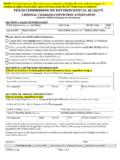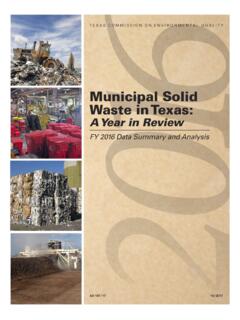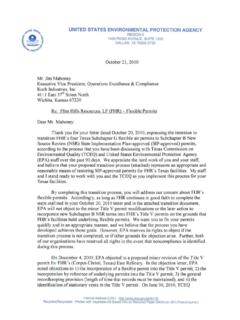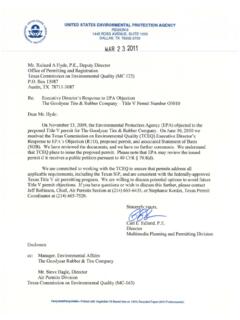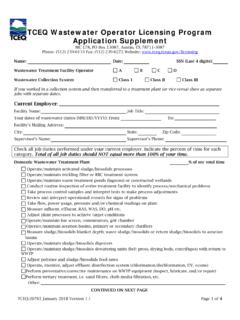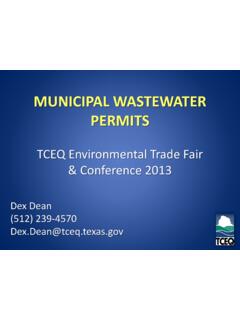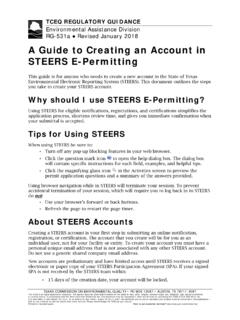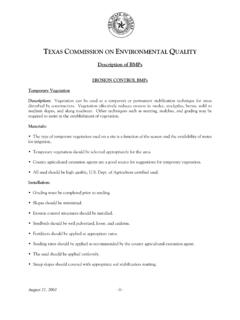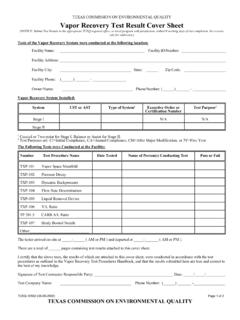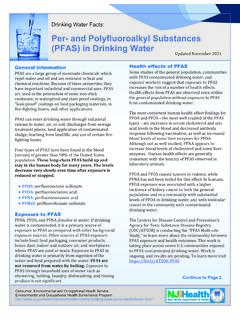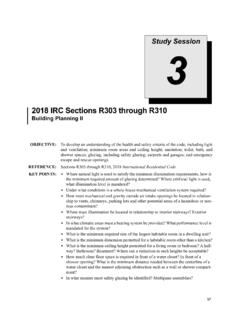Transcription of TCEQ-Modeling and Effects Review Applicability (MERA)
1 TCEQ (APDG 5874v5, Revised 03/18) Modeling and Effects Review Applicability Page i Air Permit Reviewer Reference Guide APDG 5874 Modeling and Effects Review Applicability (MERA) Air Permits Division Texas Commission on Environmental Quality March 201 8 TCEQ (APDG 5874v5, Revised 03/18) Modeling and Effects Review Applicability Page ii Table of Contents Introduction .. 1 Summary of Significant Changes .. 2 How to Determine the Scope of Modeling and Effects Review for Air Permits .. 3 Step 0: Applicability and Procedures .. 3 Step 1: No Net Increase .. 5 Step 2: De Minimis Increase .. 5 Step 3: 10% of ESL Evaluation .. 6 Step 4: Project-wide Modeling .. 8 Step 5: MSS Evaluation .. 9 Step 6: Ratio Test .. 10 Step 7: Site-wide Modeling.. 10 Step 8: Documentation .. 10 Appendix A: Glossary.
2 11 Appendix B: Toxicology Emissions Screening List .. 13 Appendix C: Screening Tables .. 14 Appendix D: Toxicology Effects Evaluation 19 Appendix E: MERA Flowchart .. 20 TCEQ (APDG 5874v5, Revised 03/18) Modeling and Effects Review Applicability Page 1 of 20 Introduction The Texas Commission on Environmental Quality (TCEQ) regulates air quality in the state of Texas through the Texas Clean Air Act (TCAA), located in Chapter 382 of the Texas health and Safety Code and rules, including those in Title 30 Texas Administrative Code (TAC) Chapter 116. The TCEQ staff conducts a preconstruction technical Review during the air permitting process. This Review ensures that the operation of a proposed facility will comply with all the rules of the TCEQ and intent of the TCAA, and not cause or contribute to a condition of air pollution.
3 A Review of an air permit application involves an assessment of human health and welfare Effects related to emissions from production and planned maintenance, startup, and shutdown (MSS) activities. The human health and welfare Effects are evaluated for applications with new and/or modified sources of air contaminants, as well as in permitting actions involving retrospective reviews or previously unevaluated emissions. Contaminants for which state air quality standards or National Ambient Air Quality Standards (NAAQS) exist are evaluated using a comparison between predicted concentrations and the standards. The evaluation procedures for these contaminants are covered in detail in the TCEQ Air Quality Modeling Guidelines APDG 6232. If there are no state or national ambient air quality standards for a contaminant , it is evaluated through the TCEQ s Modeling and Effects Review Applicability (MERA) process.
4 During the course of the MERA process, the scope of air dispersion modeling and Effects Review is determined. While this document provides a general process and defines minimum considerations for agency staff s air quality impacts analysis, this document is not regulatory and does not limit the permit reviewer s ability to require the applicant to provide additional information. In addition, the permit reviewer and Air Permits Division (APD) management have the discretion to perform an Effects Review outside of the MERA process. The MERA process begins with Step 0, which informs the user of the general procedures and practices to be followed throughout the MERA process. Steps 1 through 7 detail the criteria used to evaluate the health Effects of an air contaminant . The initial steps in the MERA process are designed to be simple and conservative.
5 As one progresses through the process, the steps require more detail and result in a more refined (less conservative) analysis. Site -wide air dispersion modeling is conducted at Step 7; and those results are evaluated using the Toxicology Effects Evaluation Procedure in Appendix D. If a contaminant , evaluated on a chemical species by chemical species basis, meets the criteria of a step, the Review of human health and welfare Effects is complete. A chemical species is said to fall out of the MERA process at this step, and the MERA document will direct the user to Step 8 to document the evaluation. If a contaminant does not meet the criteria of a step, the document will direct the user to the appropriate next step. It is acceptable to skip steps in the MERA process and proceed directly to more detailed steps.
6 This document replaces Modeling and Effects Review Applicability , APDG 5874, July 2009. TCEQ (APDG 5874v5, Revised 03/18) Modeling and Effects Review Applicability Page 2 of 20 Summary of Significant Changes Revision Date Description of Changes February 2018 Improve ease of use and clarity, removed infrequently used steps, and revised multi-point equation in previous Step 5. Chemical species for which there is not an ESL may be exempted from a MERA evaluation. July 2009 Provided additional clarity pertaining to unevaluated and MSS emissions and added Appendix D, Toxicology Effects Evaluation Procedure. August 2008 Updated requirements for APWL Constituents, added criteria for planned MSS and unevaluated emissions and added the term permit-wide, established magnitude and frequency criteria for planned MSS emissions.
7 October 2001 Removed special interest constituents, and replaced with Air Pollutant Watch List, corrected multi-point equation in Step 5, and added information about single property line designations. August 1998 Updated flowchart, added requirements for constituents of special interest, and added Effects evaluation procedures and updated the format. July 1993 Original MERA Guidance Document TCEQ (APDG 5874v5, Revised 03/18) Modeling and Effects Review Applicability Page 3 of 20 How to Determine the Scope of Modeling and Effects Review for Air Permits Step 0: Applicability and Procedures MERA Evaluation Applicability A MERA evaluation must be conducted for all chemical species whose short-term or long-term allowable emission rate will increase from any emission point number (EPN) through the project.
8 The change in an allowable emission rate is calculated as the difference between the proposed maximum allowable emission rate and the currently permitted maximum allowable emission rate. Throughout the remainder of this document allowable emission rates will be referred to as emission rates or emissions. The following are exempt from a MERA evaluation: All chemical species for which there is a state air quality standard or NAAQS, other than particulate matter species that have an Effects Screening Level (ESL) published by the TCEQ Toxicology Division. The ESL database will reference the NAAQS in place of an ESL if a MERA evaluation is not required for a particulate matter species. The Air Quality Modeling Guidelines document (APDG 6232) provides the process for evaluating chemical species for which there is a state air quality standard or NAAQS.
9 Facilities and chemical species listed on the Toxicology Emissions Screening List (see Appendix B). Chemical species for which there is not a current ESL listed in the Toxicity Factor Database, accessed through the Texas Air Monitoring Information System (TAMIS) database via the Toxicology ESL summary and detail reports. While no Effects Review is required, such chemical species must satisfy the BACT and other requirements. In addition, the permit reviewer and APD management have the discretion to perform an Effects Review outside of the MERA process. This exemption does not apply to chemical species being authorized under chemical flexibility permit provisions. General Procedures The following applies to the health Effects Review described in the MERA process, unless otherwise specified: The MERA evaluation must be conducted for each chemical species individually (except in cases where the Toxicology Division has developed an ESL for a blend such as gasoline), and must include all EPNs in the project with an increasing allowable emission rate of that chemical species.
10 A short-term impacts evaluation must be conducted for all chemical species with an increase in short-term emissions. A long-term impacts evaluation must be conducted for chemical species with an increase in long-term emissions under the following conditions: o for all chemical species with a long-term ESL that is less than 10 percent of the short -term ESL or; o if a chemical species does not have an assigned short-term ESL, but does have an assigned long-term ESL; or TCEQ (APDG 5874v5, Revised 03/18) Modeling and Effects Review Applicability Page 4 of 20 o if previous impacts were approved based on a limited frequency of exceedances. For other cases, a long-term impacts is not required unless requested by the permit reviewer. The input of a screening model is an emission rate in mass per unit of time and the output is a maximum 1- hr ground level concentration (GLCmax), in units of micrograms per cubic meter ( g/m3).
